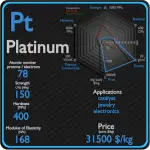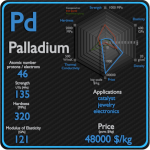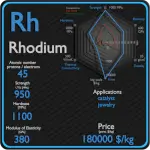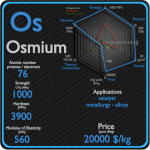This article contains comparison of key thermal and atomic properties of rhodium and iridium, two comparable chemical elements from the periodic table. It also contains basic descriptions and applications of both elements. Rhodium vs Iridium.

Rhodium and Iridium – About Elements

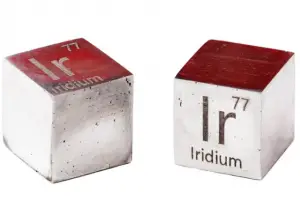
Source: www.luciteria.com
Rhodium and Iridium – Applications
Rhodium
The element’s major use (approximately 80% of world rhodium production) is as one of the catalysts in the three-way catalytic converters in automobiles. Because rhodium metal is inert against corrosion and most aggressive chemicals, and because of its rarity, rhodium is usually alloyed with platinum or palladium and applied in high-temperature and corrosion-resistive coatings. In nuclear reactors, rhodium-based detectors are often used for incore neutron flux measuring.
Iridium
Iridium is mainly consumed by the automotive, electronic, and chemical industries. Iridium metal is employed when high corrosion resistance at high temperatures is needed, as in high-performance spark plugs, crucibles for recrystallization of semiconductors at high temperatures, and electrodes for the production of chlorine in the chloralkali process. The demand for iridium surged from 2.5 tonnes in 2009 to 10.4 tonnes in 2010, mostly because of electronics-related applications that saw a rise from 0.2 to 6 tonnes – iridium crucibles are commonly used for growing large high-quality single crystals, demand for which has increased sharply.
Rhodium and Iridium – Comparison in Table
| Element | Rhodium | Iridium |
| Density | 12.45 g/cm3 | 22.65 g/cm3 |
| Ultimate Tensile Strength | 950 MPa | 2000 MPa |
| Yield Strength | N/A | N/A |
| Young’s Modulus of Elasticity | 380 GPa | 528 GPa |
| Mohs Scale | 6 | 6.25 |
| Brinell Hardness | 1100 MPa | 1670 MPa |
| Vickers Hardness | 1246 MPa | 1760 MPa |
| Melting Point | 1964 °C | 2410 °C |
| Boiling Point | 3695 °C | 4130 °C |
| Thermal Conductivity | 150 W/mK | 150 W/mK |
| Thermal Expansion Coefficient | 8.2 µm/mK | 6.4 µm/mK |
| Specific Heat | 0.242 J/g K | 0.13 J/g K |
| Heat of Fusion | 21.5 kJ/mol | 26.1 kJ/mol |
| Heat of Vaporization | 493 kJ/mol | 604 kJ/mol |
